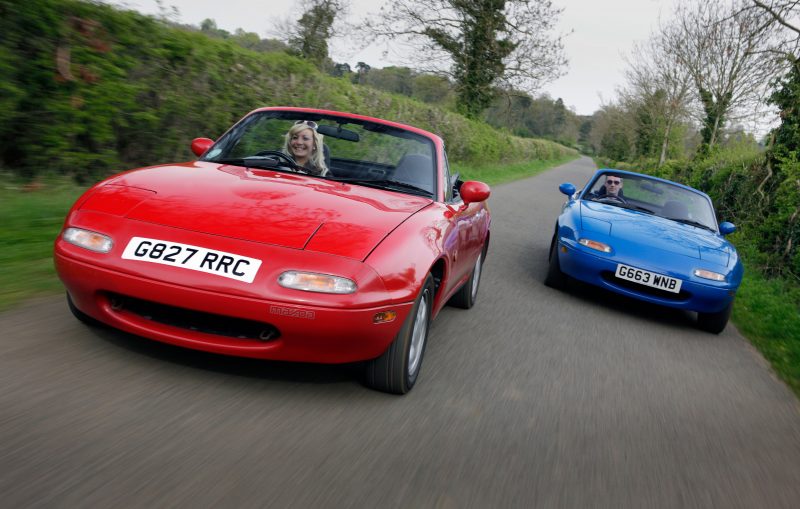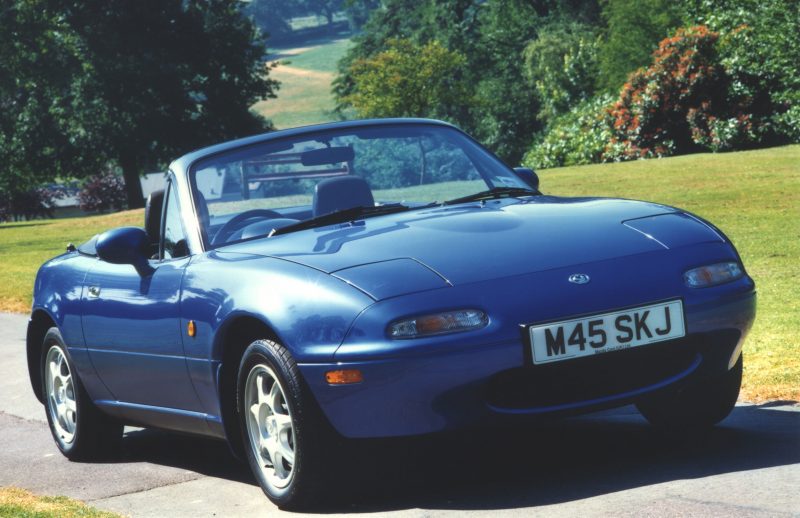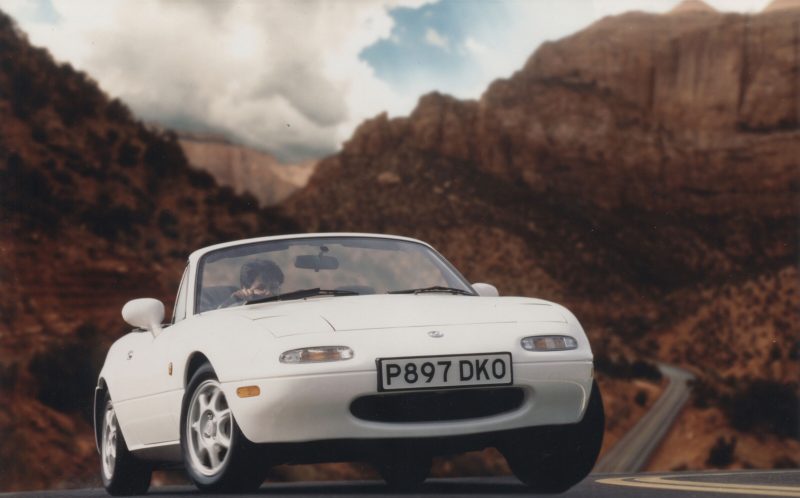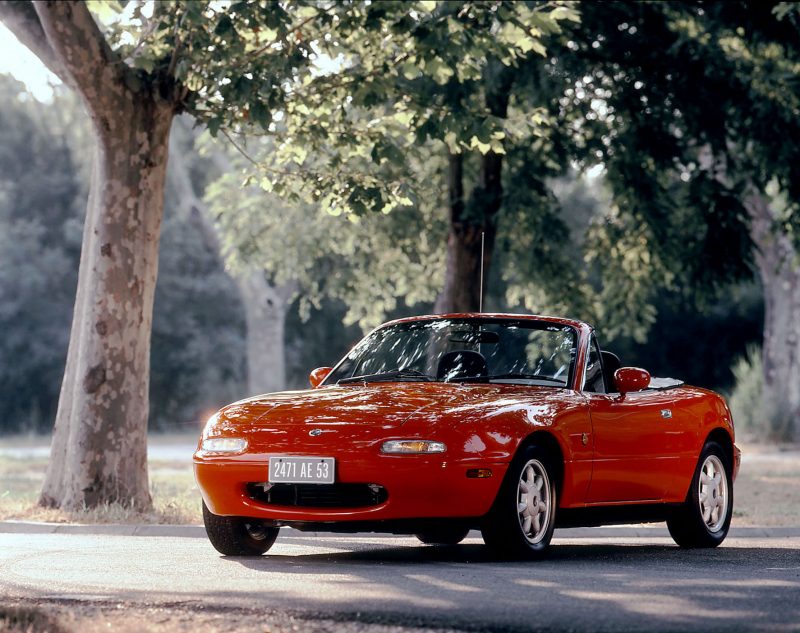The Mazda MX-5 is the world’s best-selling two-seat sports car, having sold almost a million cars since its introduction in 1989. Yet there is more to the MX-5s success than numbers; it is its sheer breadth of competence that is so astonishing. That it finally nailed the coffin lid down on the British sports car industry is undeniable; the MX-5 proved that sentiment was no substitute for proficiency.

The beginning
Work on the MX-5 started way back in 1983, which lends strength to the argument that Mazda was at least a generation ahead of any of its rivals. And though it took six years to take the car to market, many of those years were spent arguing about how innovative and complex the final car should be.
The final, long-debated answer was: not very. A simple four-cylinder engine mounted longitudinally and mated to a five-speed gearbox drove the rear wheels. The suspension was simple and elegant and the seating position low and old-fashioned. It looked like a Lotus Elan, and aped the MGB and Spitfire in concept. There was absolutely nothing about the MX-5 that was innovative or controversial or even *drops voice to a whisper*, special.
Well, except for the fact that Mazda did everything with its customary diligence. So the little car went as well as it looked, setting new benchmarks in everything it did from the gearchange to the handling, from the engine and exhaust note to the steering. The driving position was perfect for 95 percentile drivers and the folding roof didn’t leak. It was cheap to buy and cheap to run and proved that fun didn’t have to mean trouble because the MX-5s trump card was its reliability: for a world that had been led to believe that a sports car had to be unreliable, the fact that the MX-5 started, stopped, handled and ran seamlessly was a revelation. That it did so better than almost anything else you could buy was truly astonishing.
The MX-5 proved that car makers throughout the world – but mainly in Britain – had been taking the piss for decades

The details
Everything about the MK1 MX-5, or the ‘NA’ as enthusiasts refer to it, feels just right. I remember inspecting my then brother-in-law’s new car in 1990 and marvelling at the wiper mechanism. Sad, I know, but it was so simple, so perfect, so right that it proved the engineering dictum that if something looks right then it probably is right.
The gear lever is in exactly the right position, and snicks between the five gears with a precision that is uncanny. The engine starts without fuss and revs freely from cold thanks to its fuel injection system, a lesson learned from the original Volkswagen Golf GTI of 1975.
The first cars displaced 1600cc – later cars were bumped up to 1800cc to boost mid-range torque – and streaked their way to 60mph in just over 8 seconds. The top speed of 120-odd mph was a theoretical irrelevance though because the Mazda was about handling and poise rather than power and performance. No car, no matter how much you spend, is more rewarding to punt along a country lane.
Part of that appeal is the nature of the car. The styling might echo that of the original Lotus Elan but it was fresh and gorgeous and in no way a pastiche. I’ve said it before and I’ll say it again: the late eighties and early nineties were the very peak of fast, affordable car design and the MX-5 can hold its head high in any company.
The roof, which is such an integral part of the MX-5’s appeal, drops easily and demands only one hand to unfurl and furl. Nor does it flap, rattle, leak, or split. It is, in fact, absolutely unlike any fabric roof that had gone before. It just quietly and simply went on with its job of protecting the driver from the elements when necessary but being freely deployed when it wasn’t.
If you’ve never driven an MX-5 you’ll be amazed at what a sensory experience it is; pre-MX-5 the sensory experience comprised exhaust, petrol and oil fumes plus a healthy dose of run-off rainwater in the wet and an all-pervading, constantly present nagging sense of inevitable doom.
The MX-5, on the other hand, provided wind in your hair, the sun on your face, and a smile on your lips. It showed that you could be spontaneous and carefree and relaxed in the knowledge that the car would do exactly what you wanted it to do for as long as you wanted it to do it.
Nowadays, we take that sort of thing for granted, but we can only do so because the MX-5 showed the world that it was possible.
Born in 1989, the MK1 MX-5 died in 1997, although a few NA cars were sold in the UK in 1999, presumably to mop up the residual stock.

“You big girl!”
Chavs don’t like the MX-5 because it offends their understanding of what it means to be a heterosexual male while simultaneously challenging their fragile sense of self-worth. This proves (as if such a thing needed proving) that chavs are mouth-breathing idiots who haven’t got a clue what they’re talking about. (However, I will conceded that it is hard to argue the finer points of MX-5 ownership with them when they drop their half-eaten kebab on your lap when you’re sitting at traffic lights at 10 o’clock at night on a balmy Friday evening in Leeds before running off giggling.)
But having to deal with chavs is the only downside to driving an MX-5 I can think of; I had an MX-5 as my daily driver for a couple of wonderful years and apart from getting stranded in 18-inch deep snow, it never once let me down.
I took that car everywhere and apart from feeling slightly vulnerable whenever I found myself boxed in by articulated lorries on the motorway, I never once regretted buying it. (It helped that I bought mine from an ex-REME engineer who had looked after it in his fully kitted-out workshop, complete with an entire wall of shadow-boarded tools. That his OCD that exceeded my own by a factor of precisely 3.2 helped too.)
Mine made all the right noises and steered with an intuitive sharpness that bordered on telepathic. I learned about tail-out action on wet and greasy roundabouts and inch-perfect racing lines at Harewood. I experienced the pleasure of midnight drives with the roof down and only a bobble hat for company as well as the kind of existential joy that can only be achieved by bunking off work early and razzing around the North Yorkshire moors in the sun.
Yes, I sometimes wanted a bit more power but I’d then snick down a gear, floor the throttle and enjoy the feeling of my hackles rising in response to that glorious noise. It was the most perfect car I’ve ever owned and demanded nothing from me other than routine servicing and decent fuel. Which it sipped at the rate of one gallon for every 35 miles travelled no matter how I drove it.
But it was the little things I came to appreciate the most: the volcanic heater that allowed me to use it even in sub-zero temperatures; the clear dials and flawlessly ergonomic interior; the decent boot; the accessible engine; and the beautiful rifle-boot snick of those lovely little door handles. Honestly, I found something to love every single time I got into it, much less drove it.

Buying guide
Every old car rusts but few embraced the concept as enthusiastically as the baby Mazda especially around the sills, rear wheel arches, and the front chassis rails, which were the bits that killed mine. Part of the problem is that the drain tubes get blocked, which leads to water accumulating in exactly the sort of places you don’t want it to. Five minutes with a wire coat hanger will add years to your car’s life.
Repairs are possible but as anyone that has ever tried to eradicate rust will tell you, it is almost impossible to do so completely so a rust-free shell – and they do exist – should be the first tick on your (relatively short) checklist.
The next point to make is that UK-spec cars will always be worth more than grey-import Eunos models. That the cars are almost identical – save for a 112-mph speed limiter that is easily removed and a square rear number plate – is irrelevant; genuine UK cars will always be worth more, which is an important fact to note if you’re buying one as an investment but is otherwise immaterial save for the fact that buying an Eunos will save you money.
The third item on that list is to buy a car with a manual gearbox. I don’t care how tempted you are by that cheap Eunos you’ve seen for sale around the corner with the automatic ‘box; it’s still too expensive and not the way to save a few quid. Trust me, it’ll end in tears.
Finally, and I imagine that you’re well ahead of me here, you need to think long and hard about any ill-advised modifications that the car you fancy is sporting – and by that I mean any modifications. No engineer in the world is as diligent and cautious as a Mazda engineer and they chaps there did everything for a very good reason. So lowering the car will upset that carefully wrought balance, as will bigger brakes, more power, or stickier tyres. You pay your money and you take your choice but I wouldn’t want to pay much for any car with modifications that couldn’t be easily and cheaply reversed.
Except for a BBR turbo conversion, obviously. With 150bhp and 154lb/ft the BBR turbo is the car everyone says the MX-5 should have been from day one. I don’t necessarily agree but do accept that a 24bhp power hike and, more importantly, a 54lb/ft boost in torque do improve the performance without turning it into anything too unmanageable. Around 750 cars had the factory-approved, £3,700 kit installed in the UK, every single one of which maintained its Mazda warranty; praise – and endorsement – doesn’t come any higher than that. They were only available in red, white or black but that is the only compromise that buying one will foist upon you.

Modifications
Despite everything I’ve said about the care with which Mazda engineered the MX-5, some modifications are worth doing. Stiffening the bodyshell is a good place to start (although all 1.8-litre cars will have already benefitted from substantial stiffening in order to improve the side-impact resistance) and a roll-bar wouldn’t upset me too much, although your insurance company is likely to throw a hissy fit and start adding great lumps to your premium when you tell them.
Being tall, I also fitted a pair of Lotus Elise seats on custom brackets in mine to give me some more head- and leg-room; that it substantially lowers the car’s centre of gravity didn’t upset me one bit. I also find the steering wheel too big, so I substituted it for a lovely little Momo Prototipo that goes on all my cars.
I also fitted a car safe inside the spare wheel so I had somewhere to keep my phone and camera when I don’t want to take them with me and because I like a slightly fruitier exhaust (but only slightly, y’hear?) I added one of those, too. Apart from that I left it standard because that’s how God intended it to be.
Except for a long-planned-but-never-fitted turbo conversion, obviously. Yes, you can still buy a kit that’ll boost your tired old NA MX-5’s power by 40 per cent for around £2,000 from MX5 Parts.
The alternative route is to fit a supercharger, which offers much the same power as a turbocharger but does so in a more linear fashion. In either case, 200bhp should see sub-6 second 0-60mph times and a propensity to sling you off the road backwards in the wet.
The standard MX-5 chassis and gearbox should be able to handle moderate and sensible increases in power but anything over 200bhp might entail substantial suspension and brake upgrades, which will hike the final bill considerably.

Prices
You can still buy an unloved MK1 MX-5 for £500, but there are signs that this might not be the case for long. Spending a little bit more, say £2,000, gets you into a decent car that shouldn’t be too much of a money pit and £3,500 is about top-money for anything other than museum-quality static exhibits.
Original BBR Turbo cars are hard to price, mainly because there are so few of them about. However, £2,000 should see you behind the wheel of a project car while £4-5,000 should buy a minter.
Carlton Boyce